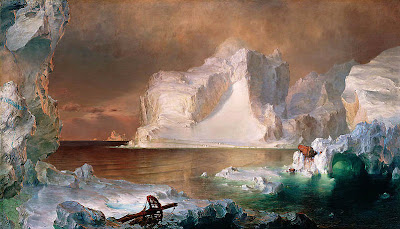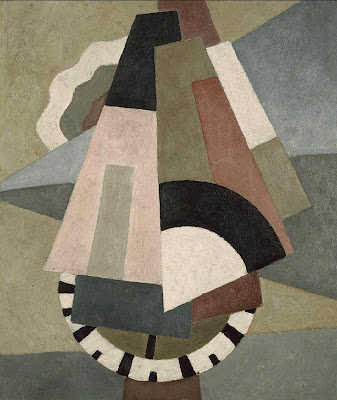Ivan Kliun, Studies in Color, c. 1917; oil on cardboard, 11 1/4 x 8 7/6 in.
All images courtesy of the Museum of Modern Art's excellent
website.
There is a glorious show at the
Museum of Modern Art, one that thrilled and delighted me with its mix of beloved artists such as Malevich and Mondrian, artists new to me, and surprising work by artists I thought I knew. Titled
Inventing Abstraction: 1910-1925, it brings together work from artists throughout Europe and the United States in an exciting mix of styles and mediums. I did not title this blog post with the title of the exhibition because I think that title is an unfortunate one, since abstraction has been a part of art making for thousands of years, in cultures throughout the globe; what was new was European artists using non-objective forms, with expanding explorations. Roger Denson wrote an extensive and passionate essay on this, which you can
read here. There have been other critical complaints about the show, about the blinkered focus of the curator, about those artists left out––why Picasso and not Matisse?; where is Miro?
asked Jed Perl; what about
Hilma af Klint or
George Ohr?
Jerry Saltz wants to know––but the show is still a tremendous achievement, a gathering of work that delights, teaches, and inspires me.
I decided that for this post, I would show work that of artists I didn't know at all, or surprising works by artists I thought I knew. Ivan Kliun was a Russian artist, a colleague of Kazimir Malevich; I think I can say that his series of small works on cardboard, which you can see
here, were my favorite paintings not previously known to me. (The wall of Malevich paintings was pretty spectacular too [you can see it at the
NY Times], as was that of Mondrian.) Each a simple shape in a single color, some cut off by the edge of the board, they were richly painted, vivid presences. Kliun believed, like Malevich, "art has ceased to be a means and has become and end in itself", a Suprematist belief. In her essay on
Suprematism in the Malevich catalog,
Kazimir Malevich: Suprematism, Nina Gurianova also points out that it was also "a spiritual quest". Much of the new abstraction had a mystical or spiritual component, a search for a truth behind appearances, for essential form.

El Lissitzky, Proun 1C, 1919; oil and metal foil on plywood, 26 3/4 x 26 3/4 in.
I love this painting by Lizzitzky, another colleague of Malevich, with its dramatically solid volumes floating in a boundless space, but also situated by forms and lines at its edges. Who would think to place a line and tiny circle at the left, a group of mysterious lines at right, forms falling from the bottom? It creates a compelling vision of a new world.
Vasily Kandinsky, Color Study––Squares with Concentric Rings, 1913; watercolor, gouache, and crayon on paper, 9 3/8 x 12 3/8 in.
Kandinsky was a very important figure in early abstraction, with his paintings and his book
Concerning the Spiritual in Art, in which he spoke of being part of a group of "painters, poets, musicians, dramatists, critics, all working to the same end––the expression of the soul of nature and humanity...".
This cross-disciplinary attitude is one that the exhibition emphasizes. I've never been a fan of Kandinsky's paintings, but I did love this wacky color study.
Vaslav Nijinsky, Untitled (Arcs and Segments: Lines), 1918-19; crayon and pencil on paper, 11 1/4 x 14 3/4 in.
As a perfect example of both an artist crossing disciplinary boundaries and of depicting the spiritual, the exhibition presented drawings by great Russian dancer Nijinsky, who wrote that he based his drawings on the circle: "the complete, the perfect movement. Everything is based on it––life, art, and most certainly our art" of dance. These drawings are wonderful, very direct and simple, relating to sacred art in their forms. The Russian artists in this show, such as the four above, show that political ferment was a great leavening for artistic innovation.
Giacomo Balla, Study for Iridescent Interpenetration, 1912; 6 15/16 x 7 3/8 in.
Balla was a member of the Italian
Futurists, whose work I don't admire, partly because of their political ideology. But I loved the three watercolor color studies by Balla on view, especially this one, with its form like an unfolding spiky flower.
Duncan Grant, Interior at Gordon Square, ca. 1914-15; collage on board, 30 1/16 x 25 1/4 in.
Vanessa Bell, Abstract Painting, c. 1914; gouache and oil on canvas, 17 3/8 x 15 1/8 in.
Moving to England, here are two artists, Duncan Grant and Vanessa Bell, who were later known for their representational painting, but here have experimented in more abstract form. I really like Grant's use of the collage medium; his interior seems to owe a debt to Matisse's work of the year
1914. The Bell is a luminous work: I love the placement of elements, and that very pink square at the upper right.
Wyndham Lewis, Portrait of an Englishwoman, 1913 or 1914; ink, pencil, and watercolor on paper,
22 1/16 x 14 15/16 in.
There was more dynamic English painting totally new to me, including this Lewis work, which has a feeling of toppling architecture...
Helen Saunders, Canon, c. 1915; pencil and gouache on paper, 14 1/2 x 11 3/4 in.
...and this Saunders painting, also ecstatically, geometrically moving and shaking. Lewis and Saunders were part of the
Vorticist group, which promoted activity, significance, essential movement.
Marsden Hartley, Provincetown, 1916; oil on board, 24 x 10 1/16 in.
I can see something of a relationship between the American Marsden Hartley's painting
Provincetown and the two paintings above, all with a tumble of architectual-looking geometric forms. The exhibition had two of Hartley's well known Berlin paintings, but on another wall were three more simple abstractions, including this one, which I loved. The color is subtle but also very juicy, the composition moving like a teeter-totter.
Arthur Dove, Pagan Philosophy, 1913; pastel on board, 21 3/8 x 17 7/8 in.
I love the dark, rich, mysteriousness of this Dove pastel, with its sense of moving shapes, machine-like and organic. Dove saw a show of Picasso's cubist works in NYC at Stieglitz's 291 gallery and then wrote in a notebook: "I would like to make something that is real itself, that does not remind anyone else of any other thing, and that does not have to be explained––like the letter A, for instance".
Wladyslaw Strzeminski, Architectonic Composition (1), 1926; oil on canvas, 35 7/16 x 25 3/16 in.
I was struck by the straightforward geometry of this painting, its gray and white color. When I read the caption about the work, it was an ah-hah moment, because Strzeminski's aim in his own form of abstraction that he called Unism was to unify figure and ground. Doing that is also my aim in a series of textiles that I call the figure/ground series, some of which you can
see here. I wrote above that the works in this show inspire me: I have used this compositional idea, turned 45 degrees, for a textile I'm working on now.
Waclaw Szpakowski, From the Series B:B6, 1924; ink on tracing paper, 13 5/16 x 15 7/8 in.
Just ink on tracing paper...but so completely engaging and fascinating. A reproduction doesn't give the quality of the deep, dark black on the fragile surface, the insistence of the lines. What you can see is the jumping optical effect. On the museum website I learned that Szpakowski made all his lines by hand, and that he felt they expressed "the underlying mathematical order of the universe".
Sophie Taeuber-Arp, Untitled (Composition with Squares, Circle, Rectangles, Triangles), 1918;
wool needlepoint, 24 x 24 5/8 in.
I was very excited to see this needlepoint by Taeuber-Arp, along with other textile work in the show; this especially interested me because of her use of a colored ground with needlepoint elements on top of it; it's gotten my mind going on some new ideas. She and her husband Hans Arp taught at the School of Applied Arts in Zurich where they tried to level any distinctions between fine and applied arts.
What was so marvelous about this show was the sheer range of expression, the wide variety of styles coming out of the idea to leave representation behind. There are so many thoughts to ponder, so much sheer pleasure to be had. It will be on exhibit until April 15th, so I urge you to go if you can. If not, there is an extensive
website. It is helpful to start
here at the checklist, to get an overview of everything in the show, which you can then explore in depth. Enjoy!

















































